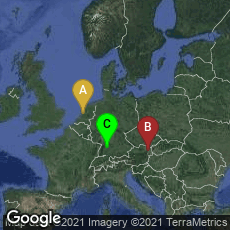

A: Amsterdam-Centrum, Amsterdam, Noord-Holland, Netherlands, B: Innere Stadt, Wien, Wien, Austria, C: Tübingen, Baden-Württemberg, Germany
In 1900 three scientists independently rediscovered Mendel's laws or ratios, which had remained unnoticed by the scientific community since Mendel had originally published them in 1866. Both de Vries and Correns rediscovered the laws before reading Mendel's paper.
Dutch botanist and geneticist Hugo de Vries published his account of the rediscovery in two papers:
"Sur la loi de disjonction des hybrides," Comptes rendus Academie des Sciences (Paris) 130 (1900) 845-47.
His more detailed paper was "Das Spaltungsgestetz der Bastarde," Berichte der Deutsche Botanischen
Gesellschaft 18 (1900) 83-90.
Reading de Vries's paper in German led German botanist and geneticist Carl Correns of the University of Tübingen to write his own paper, although Correns claimed he had previously and independently arrived at the same conclusions. Correns's paper was:
"G. Mendel's Regel über das Verhalten der Nachkommenschaft der Rassenbastarde," Berichte der Deutsche Botanischen
Gesellschaft 18 (1900) 158-67.
The third scientist to "rediscover" Mendel's laws was the Austrian agronomist Erich Tschermak, Edler von Seysenegg (Erich von Tschermak). Tschermak's first paper on the subject was:
"Über künstsliche Kreuzung bei Pisum sativum," Berichte der Deutsche Botanischen Gessellschaft 18 (1900) 232-39.
His more detailed paper was "Über künstliche Kreuzung von Pisum sativum," Z. landwirsch. Versuchsw. in Osterreich," 3 (1900) 465-555.
Along with de Vries and Correns, Tschermak brought Mendel's work into prominence and confirmed it, though it is thought that Tschermak may not have fully understood the Mendelian laws before he read Mendel's work.
♦ Rediscovery of Mendel's laws clarified inheritance, but Mendel worked with traits of whole organisms (plants). How characteristics are sorted and combined on a cellular level where reproduction takes place became the research projects of 20th century scientists.
J. Norman (ed) Morton's Medical Bibliography 5th ed (1991) nos. 239.01, 239.1, 239.2.